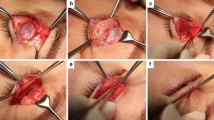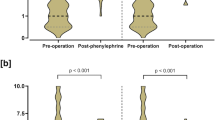Abstract
Background
The purpose of this paper is to report the outcome of retrotarsal tucking of Müller muscle-levator aponeurosis for the correction of borderline to moderate ptosis in conjunction with esthetic blepharoplasty in Asian eyelids and to explore the relationship between the extent of advancement and change in the eyelid position (MRD1).
Methods
The medical records of 290 consecutive patients who underwent retrotarsal tucking of Müller muscle-levator aponeurosis from February 2005 to November 2011 were reviewed. Of those, 26 patients (51 eyelids) were statistically analyzed. The correction was performed through an external upper blepharoplasty approach. Once the orbital septum was opened, the Müller muscle-levator aponeurosis was advanced and tucked under the posterior surface of the tarsus by a single lifting suture. The average follow-up period was 20.6 months, with a range of 3–68 months.
Results
In 26 patients (51 eyelids), satisfactory results were recorded for 49 of 51 eyelids (96.1 %). The margin reflex distance-1 (MRD1) increased from 1.56 ± 0.70 mm preoperatively to 3.86 ± 0.94 mm postoperatively (p < 0.001, Wilcoxon signed rank test). When 6.1 mm of advancement was implemented, an average MRD1 of 1 mm was achieved. For 7.2 and 8.3 mm of advancement, the average MRD1 achieved was 2 and 3 mm each. A noteworthy complication, although not included in statistical analysis, was one patient who had developed corneal irritation caused by the conjunctival exposure to the non-absorbable suture 3 years after the surgery, which led the subject to have the suture removed.
Conclusion
The author concludes that this procedure is one of the most effective surgical options in correcting borderline to moderate blepharoptosis in conjunction with esthetic blepharoplasty. The main advantage of such a method is that once the orbital septum is opened, Müller muscle-levator aponeurosis is easily advanced and tucked under the posterior surface of the tarsal plate without extensive dissection or resection, which is less traumatic and gives a more vertical lifting vector, thus producing excellent cosmetic results and quick recovery.
Level of Evidence V
This journal requires that authors assign a level of evidence to each article. For a full description of these Evidence-Based Medicine ratings, please refer to the Table of Contents or the online Instructions to Authors www.springer.com/00266.






Similar content being viewed by others
References
Park SG, Lee SK, Baek RM (2006) A new interpretation of ptosis-like eyes through the results of small-incision double-eyelid operation. J Korean Soc Plast Reconstr Surg 33(4):449–453 Korean
Li J, Lin M, Zhou H, Jia R, Fan X (2011) Double-eyelid blepharoplasty incorporating blepharoptosis surgery for ‘latent’ aponeurotic ptosis. J Plast Reconstr Aesthet Surg 64(8):993–999
Ha KY, Suh HW, Kim BY, Kim TY, Park SG (2010) Correlation analysis of ocular dominance and levator palpebrae superioris muscle function. J Korean Soc Plast Reconstr Surg 37(3):265–270 Korean
Jones LT, Quickert MH, Wobig JL (1975) The cure of ptosis by aponeurotic repair. Arch Ophthalmol 93(8):629–634
Harris WA, Dortzbach RK (1975) Levator tuck: a simplified blepharoptosis procedure. Ann Ophthalmol 7(6):873–878
Liu D (1993) Ptosis repair by single suture aponeurotic tuck. Surgical technique and long-term results. Ophthalmology 100(2):251–259
Putterman AM, Urist MJ (1975) Müller muscle-conjunctiva resection. Technique for treatment of blepharoptosis. Arch Ophthalmol 93(8):619–623
Putterman AM, Fett DR (1986) Müller’s muscle in the treatment of upper eyelid ptosis: a ten-year study. Ophthalmic Surg 17(6):354–360
Beard C (1985) Müller’s superior tarsal muscle: anatomy, physiology, and clinical significance. Ann Plast Surg 14(4):324–333
Dresner SC (1991) Further modifications of the Müller’s muscle-conjunctival resection procedure for blepharoptosis. Ophthal Plast Reconstr Surg 7(2):114–122
Bang YH, Park SH, Kim JH, Cho JH, Lee CJ, Roh TS (1998) The role of Müller’s muscle reconsidered. Plast Reconstr Surg 101(5):1200–1204
Haramoto U, Kubo T, Tamatani M, Hosokawa MK (2001) Anatomic study of the insertions of the levator aponeurosis and Müller’s muscle in oriental eyelids. Ann Plast Surg 47(5):528–533
Kakizaki H, Zako M, Nakano T, Asamoto K, Miyaishi O, Iwaki M (2005) The levator aponeurosis consists of two layers that include smooth muscle. Ophthal Plast Reconstr Surg 21(5):379–382
Baik BS, Kim TB, Hong WK, Yang WS (2005) Muller’s muscle-levator aponeurosis advancement procedure for blepharoptosis. J Korean Soc Plast Reconstr Surg 32(2):219–226 Korean
Baik BS, Suhk JH, Choi WS, Yang WS (2009) Treatment of blepharoptosis by the advancement procedure of the muller’s muscle-levator aponeurosis composite flap. J Korean Soc Plast Reconstr Surg 36(2):211–220 Korean
Park JW, Shin HS, Park ES, Kim YB (2006) Balanced tucking of the levator muscle and muller’s muscle in blepharoptosis. J Korean Soc Plast Reconstr Surg 33(2):149–154 Korean
Park DH, Baik BS (2008) Advancement of the Müller muscle-levator aponeurosis composite flap for correction of blepharoptosis. Plast Reconstr Surg 122(1):140–142
Halliday D et al (2005) Fundamentals of Physics, vol 7. Wiley, New York, pp 281–282
Oh CH (2009) Analysis of postoperative complications in blepharoptosis. J Korean Soc Plast Reconstr Surg 36(6):743–749 Korean
Bae TH (2003) A Photogrammetic study of the eyes in Korean youths. J Korean Soc Plast Reconstr Surg 34:37–41 Korean
Park DH, Baik BS (1998) Cosmetic and reconstructive oculoplastic surgery, 1st edn. Koonja Publishing, Inc., Seoul 241
Lee MG, Kim HC, Minn KW (1995) Levator advancement for correction of blepharoptosis. J Korean Soc Plast Reconstr Surg 22:1386 Korean
Uchida J (1962) A surgical procedure for blepharoptosis vera and for pseudo-blepharoptosis orientalis. Br J Plast Surg 15:271–276
Park DH, Baik BS, Nahai F (2009) Cosmetic and reconstructive oculoplastic surgery, 3rd edn. Koonja Publishing, Inc., Seoul, p 149–186, 509–563
Yuzuriha S, Matsuo K, Kushima H (2000) An anatomical structure which results in puffiness of the upper eyelid and a narrow palpebral fissure in the Mongoloid eye. Br J Plast Surg 53(6):466–472
Meltzer MA, Elahi E, Taupeka P, Flores E (2001) A simplified technique of ptosis repair using a single adjustable suture. Ophthalmology 108(10):1889–1892
Kuwabara T, Cogan DG, Johnson CC (1975) Structure of the muscles of the upper eyelid. Arch Ophthalmol 93(11):1189–1197
Matsuo K (2002) Stretching of the Mueller muscle results in involuntary contraction of the levator muscle. Ophthal Plast Reconstr Surg 18(1):5–10
Park DH, Kim CW, Shim JS (2008) Strategies for simultaneous double eyelid blepharoplasty in Asian patients with congenital blepharoptosis. Aesthetic Plast Surg 32(1):66–71
Conflict of interest
The authors declare that they have no conflict of interest.
Author information
Authors and Affiliations
Corresponding author
Rights and permissions
About this article
Cite this article
Chung, S., Ahn, B., Yang, W. et al. Borderline to Moderate Blepharoptosis Correction Using Retrotarsal Tucking of Müller Muscle: Levator Aponeurosis in Asian Eyelids. Aesth Plast Surg 39, 17–24 (2015). https://doi.org/10.1007/s00266-014-0420-5
Received:
Accepted:
Published:
Issue Date:
DOI: https://doi.org/10.1007/s00266-014-0420-5




